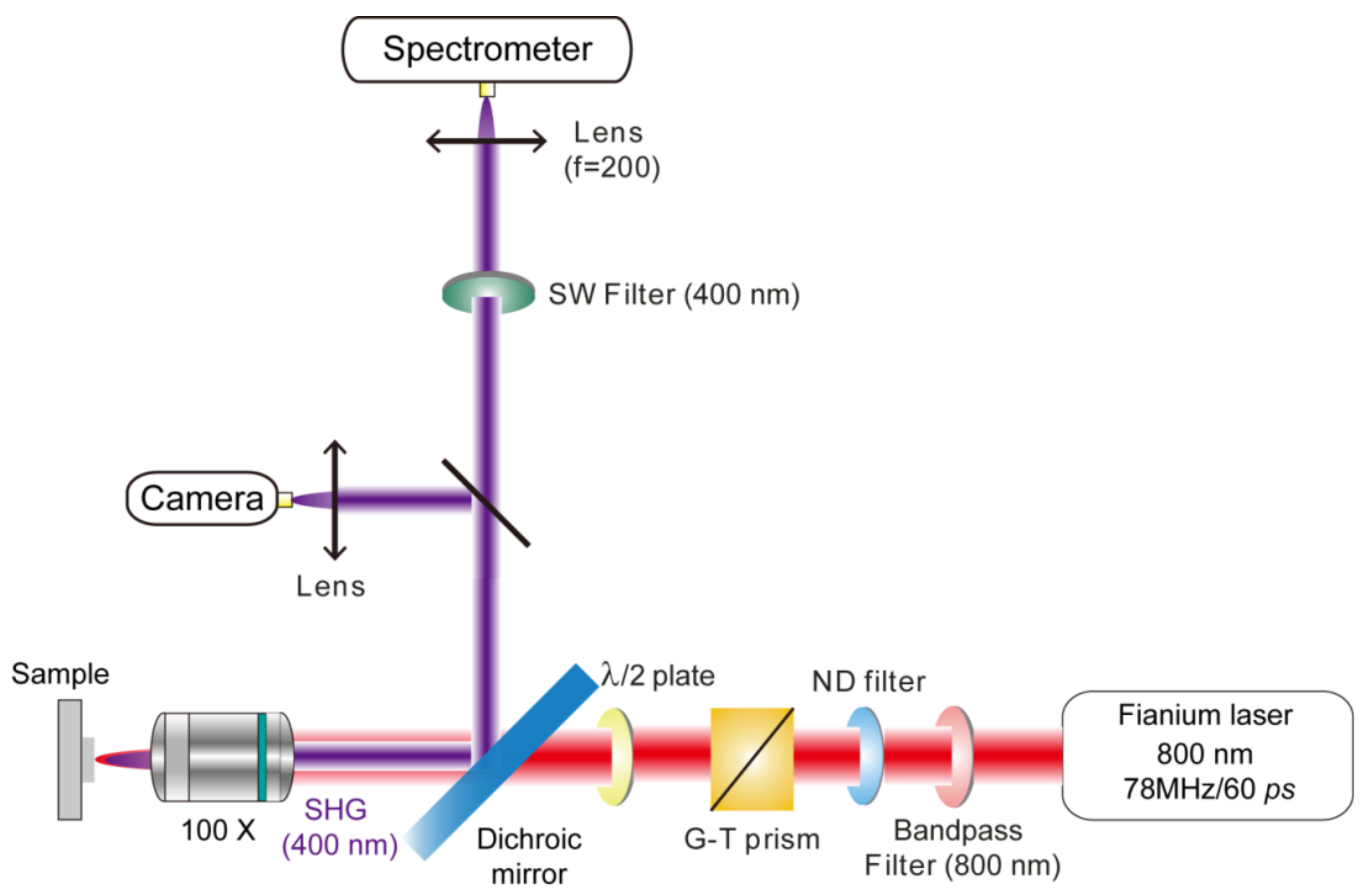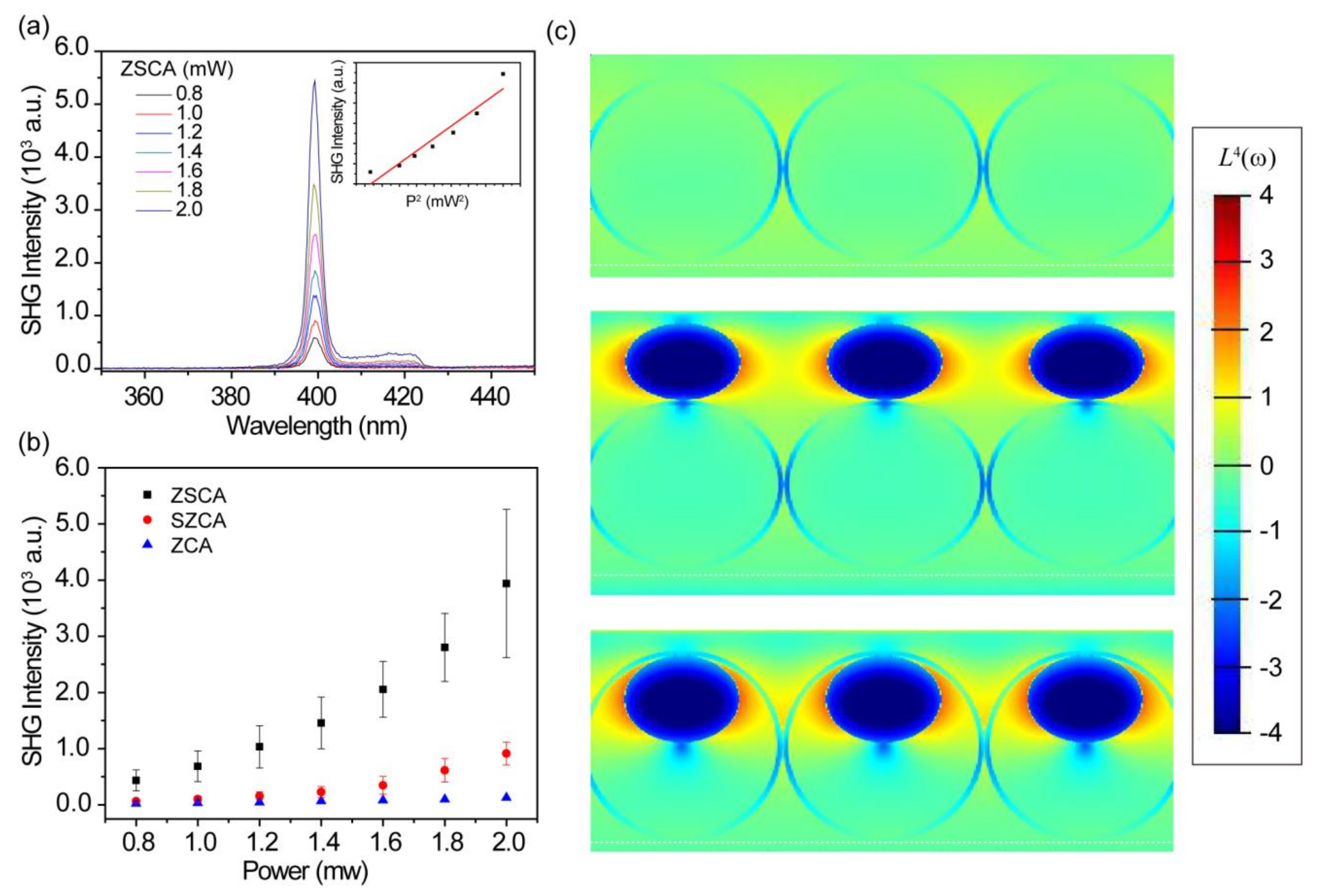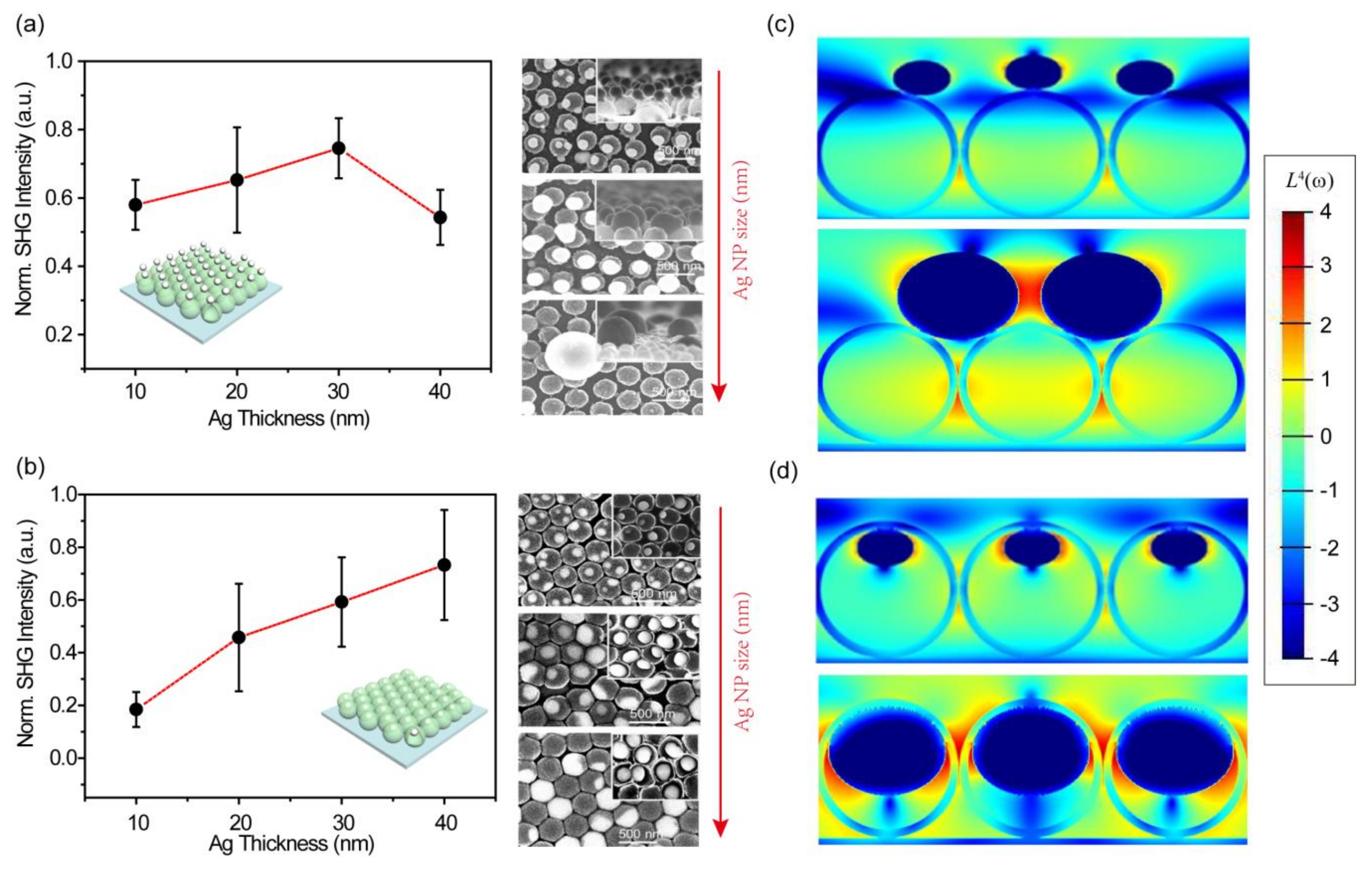Spatially-Controllable Hot Spots for Plasmon-Enhanced Second-Harmonic Generation in AgNP-ZnO Nanocavity Arrays
Abstract
:1. Introduction
2. Materials and Methods
2.1. Sample Preparation
2.2. SHG Measurement
2.3. Computational Method
3. Results and Discussions
3.1. Fabrication and Characterization
3.1.1. Morphology and Elemental Analysis
3.2. Optical Spectroscopy and Simulations
3.2.1. Geometry-Dependent PESHG Performances
3.2.2. Characteristics of Multimode Matching
4. Conclusions
Supplementary Materials
Author Contributions
Funding
Acknowledgments
Conflicts of Interest
References
- Kauranen, M.; Zayats, A.V. Nonlinear plasmonics. Nat. Photonics 2012, 6, 737–748. [Google Scholar] [CrossRef]
- Kim, E.; Steinbruuk, A.; Buscaglia, M.T.; Buscaglia, V.; Pertsch, T.; Grange, R. Second-harmonic generation of single BaTiO3 nanoparticles down to 22 nm diameter. ACS Nano 2013, 7, 5343–5349. [Google Scholar] [CrossRef] [PubMed]
- Djurisic, A.B.; Leung, Y.H. Optical properties of ZnO nanostructures. Small 2006, 2, 944–961. [Google Scholar] [CrossRef] [PubMed]
- Liu, W.W.; Wang, K.; Liu, Z.; Shen, G.Z.; Lu, P.X. Laterally emitted surface second harmonic generation in a single ZnTe nanowire. Nano Lett. 2013, 13, 4224–4229. [Google Scholar] [CrossRef] [PubMed]
- Chervinskii, S.; Koskinen, K.; Scherbak, S.; Kauranen, M.; Lipovskii, A. Nonresonant local fields enhance second-harmonic generation from metal nanoislands with dielectric cover. Phys. Rev. Lett. 2018, 120, 113902. [Google Scholar] [CrossRef] [PubMed]
- Ren, M.L.; Liu, W.J.; Aspetti, C.O.; Sun, L.X.; Agarwal, R. Enhanced second harmonic generation from metal-integrated semiconductor nanowires via highly confined whispering gallery modes. Nat. Commun. 2014, 5, 54329. [Google Scholar] [CrossRef] [PubMed]
- Richter, J.; Steinbruck, A.; Zilk, M.; Sergeyev, A.; Pertsch, T.; Tunnermann, A.; Grange, R. Core–shell potassium niobate nanowires for enhanced nonlinear optical effects. Nanoscale 2014, 6, 5200–5207. [Google Scholar] [CrossRef]
- Li, Y.; Kang, M.; Shi, J.J.; Wu, K.; Zhang, S.P.; Xu, H.X. Transversely divergent second harmonic generation by surface plasmon polaritons on single metallic nanowires. Nano Lett. 2017, 17, 7803–7808. [Google Scholar] [CrossRef]
- Dutto, F.; Heiss, M.; Lovera, A.; Lόpez-Sánchez, O.; Fontcuberta i Morral, A.; Radenovic, A. Enhancement of second harmonic signal in nanofabricated cones. Nano Lett. 2013, 13, 6048–6054. [Google Scholar] [CrossRef]
- Lehr, D.; Reinhold, J.; Thieel, I.; Hartung, H.; Dietrich, K.; Menzel, C.; Pertsch, T.; Kley, E.B.; Tünnermann, A. Enhancing second harmonic generation in gold nanoring resonators filled with Lithium Niobate. Nano Lett. 2015, 15, 1025–1030. [Google Scholar] [CrossRef]
- O’Brien, K.; Suchowski, H.; Rho, J.; Salandrino, A.; Kante, B.; Yin, X.B.; Zhang, X. Predicting nonlinear properties of metamaterials from the linear response. Nat. Mater. 2015, 14, 379–383. [Google Scholar] [CrossRef] [PubMed]
- Chen, S.; Zhang, Y.J.; Shih, T.M.; Yang, W.M.; Hu, S.; Hu, X.Y.; Li, J.F.; Ren, B.; Mao, B.W.; Yang, Z.L.; et al. Plasmon-induced magnetic resonance enhanced Raman spectroscopy. Nano Lett. 2018, 18, 2209–2216. [Google Scholar] [CrossRef] [PubMed]
- Celebrano, M.; Wu, X.F.; Baselli, M.; Großmann, S.; Biagioni, P.; Locatelli, A.; De Angelis, C.; Cerullo, G.; Osellame, R.; Hecht, B.; et al. Mode matching in multiresonant plasmonic nanoantennas for enhanced second harmonic generation. Nat. Nanotechnol. 2015, 10, 412–417. [Google Scholar] [CrossRef] [PubMed] [Green Version]
- Shen, S.; Meng, L.Y.; Zhang, Y.; Han, J.; Ma, Z.; Hu, S.; He, Y.; Li, J.F.; Ren, B.; Shih, T.M. Plasmon-enhanced second-harmonic generation nanorulers with ultrahigh sensitivities. Nano Lett. 2015, 15, 6716–6721. [Google Scholar] [CrossRef] [PubMed]
- Chen, S.; Meng, L.Y.; Shan, H.Y.; Li, J.F.; Qian, L.H.; Williams, C.T.; Yang, Z.L.; Tian, Z.Q. How to light special hot spots in multiparticle-film configurations. ACS Nano 2016, 10, 581–587. [Google Scholar] [CrossRef] [PubMed]
- Shiao, M.H.; Lin, C.T.; Zeng, J.J.; Lin, Y.S. Novel gold dendritic nanoforests combined with titanium nitride for visible-light-enhanced chemical degradatio. Nanomaterials 2018, 8, 282. [Google Scholar] [CrossRef] [PubMed]
- Darweesh, A.A.; Bauman, S.J.; Debu, D.T.; Herzog, J.B. The role of Rayleigh-Wood anomalies and surface plasmons in optical enhancement for nano-gratings. Nanomaterials 2018, 8, 809. [Google Scholar] [CrossRef] [PubMed]
- Wang, F.; Martinson, A.B.F.; Harutyunyan, H. Efficient nonlinear metasurface based on nonplanar plasmonic nanocavities. ACS Photonics 2017, 4, 1188–1194. [Google Scholar] [CrossRef]
- Zakharko, Y.; Nychyporuk, T.; Bonacina, L.; Lemiti, M.; Lysenko, V. Plasmon-enhanced nonlinear optical properties of SiC nanoparticles. Nanotechnology 2013, 24, 055703. [Google Scholar] [CrossRef]
- Liu, S.D.; Leong, E.S.P.; Li, G.C.; Hou, Y.D.; Deng, J.; Teng, J.H.; Ong, H.C.; Lei, D.Y. Polarization-independent multiple Fano resonances in plasmonic nonamers for multimode-matching enhanced multiband second-harmonic generation. ACS Nano 2016, 10, 1442–1453. [Google Scholar] [CrossRef]
- Xu, H.X.; Bjerneld, E.J.; Kall, M.; Börjesson, L. Spectroscopy of single hemoglobin melecules by surface enhanced Raman scattering. Phys. Rev. Lett. 1999, 83, 4357–4360. [Google Scholar] [CrossRef]
- Pu, Y.; Grange, R.; Hsieh, C.L.; Psaltis, D. Nonlinear optical properties of Core-Shell nanocavities for enhanced second harmonic generation. Phys. Rev. Lett. 2010, 104, 207402. [Google Scholar] [CrossRef] [PubMed]
- Ren, M.L.; Liu, S.Y.; Wang, B.L.; Chen, B.Q.; Li, J.F.; Li, Z.Y. Giant enhancement of second harmonic generation by engineering double plasmonic resonances at nanoscale. Opt. Express 2014, 22, 28653–28661. [Google Scholar] [CrossRef] [PubMed]
- Jassim, N.M.; Wang, K.; Han, X.B.; Long, H.; Wang, B.; Lu, P.X. Plasmon assisted enhanced second-harmonic generation in single hybrid Au/ZnS nanowires. Opt. Mater. 2017, 64, 257–261. [Google Scholar] [CrossRef]
- Deckman, H.W.; Dunsmuir, J.H. Natural lithography. Appl. Phys. Lett. 1982, 41, 377–379. [Google Scholar] [CrossRef]
- Haynes, C.L.; Van Duyne, R.P. Nanosphere lithography: A versatile nanofabrication tool for studies of size-dependent nanoparticle. J. Phys. Chem. B 2001, 105, 5599–5611. [Google Scholar] [CrossRef]
- Zang, Y.S.; Yin, J.; He, X.; Yue, C.; Wu, Z.M.; Li, J.; Kang, J.Y. Plasmonic-enhanced self-cleaning activity on asymmetric Ag/ZnO surface-enhanced Raman scattering substrates under UV and visible light irradiation. J. Mater. Chem. A 2014, 2, 7747–7753. [Google Scholar] [CrossRef]
- Zang, Y.S.; He, X.; Li, J.; Yin, J.; Yue, C.; Wu, Z.M.; Wu, S.T.; Kang, J.Y. Band edge emission enhancement by quadrupole surface plasmon–exciton coupling using direct-contact Ag/ZnO nanospheres. Nanoscale 2013, 5, 574–580. [Google Scholar] [CrossRef]
- Zhang, J.H.; Chen, Z.; Wang, Z.L.; Zhang, W.Y.; Ming, N.B. Preparation of monodisperse polystyrene spheres in aqueous alcohol system. Mater. Lett. 2003, 57, 4466–4470. [Google Scholar] [CrossRef]
- Yu, J.; Yan, Q.F.; Shen, D.Z. Co-self-assembly of binary colloidal crystals at the air-water interface. ACS Appl. Mater. Interfaces 2010, 2, 1922–1926. [Google Scholar] [CrossRef]
- Taflove, A.; Hagness, S. Computational Electrodynamics: The Finite-Difference Time-Domain Method; Artech House: Norwood, OH, USA, 2005. [Google Scholar]
- Yang, Z.L.; Li, Q.H.; Ruan, F.X.; Li, Z.P.; Ren, B.; Xu, H.X.; Tian, Z.Q. FDTD for plasmonics: Applications in enhanced Raman spectroscopy. Chin. Sci. Bull. 2010, 55, 2635–2642. [Google Scholar] [CrossRef]
- Berenger, J.P. A perfectly matched layer for the absorption of electromagnetic waves. J. Comput. Phys. 1994, 114, 185–200. [Google Scholar] [CrossRef]
- Johnson, P.B.; Christy, R.W. Optical constants of the noble metals. Phys. Rev. B 1972, 6, 4370–4379. [Google Scholar] [CrossRef]
- Sharma, S.; Vyas, S.; Periasamy, C.; Chakrabarti, P. Structural and optical characterization of ZnO thin films for optoelectronic device applications by RF sputtering technique. Superlattices Microstruct. 2014, 75, 378–389. [Google Scholar] [CrossRef]
- Wang, C.Y.; Chen, H.Y.; Sun, L.Y.; Chen, W.L.; Chang, Y.M.; Ahn, H.; Li, X.Q.; Gwo, S. Giant colloidal silver crystals for low-loss linear and nonlinear plasmonics. Nat. Commun. 2015, 6, 7734. [Google Scholar] [CrossRef] [Green Version]
- Yang, M.M.; Shen, S.X.; Wang, X.J.; Yu, B.B.; Huang, S.L.; Xu, D.; Hu, J.W.; Yang, Z.L. Plasmon-enhanced second-harmonic generation from hybrid ZnO-covered silver-bowl array. J. Phys. Condens. Matter 2016, 28, 214003. [Google Scholar] [CrossRef]
- Chen, C.K.; de Castro, A.R.B.; Shen, Y.R. Surface-enchanced second harmonic generation. Phys. Rev. Lett. 1981, 46, 145–148. [Google Scholar] [CrossRef]
- Slablab, A.; Le Xuan, L.; Zielinski, M.; de Wilde, Y.; Jacques, V.; Chauvat, D.; Roch, J.F. Second harmonic generation from coupled plasmon modes in a single dimer of gold nanospheres. Opt. Express 2012, 20, 220–227. [Google Scholar] [CrossRef]
- Butet, J.; Dutta-Gupta, S.; Martin, O.J.F. Surface second harmonic generation from coupled spherical plasmonic nanoparticles: Eigenmode analysis and symmetry properties. Phys. Rev. B 2014, 89, 245449. [Google Scholar] [CrossRef]
- Metzger, B.; Gui, L.L.; Fuchs, J.; Floess, M.; Hentschel, M.; Giessen, H. Strong enhancement of second harmonic emission by plasmonic resonances at the second harmonic wavelength. Nano Lett. 2015, 15, 3917–3922. [Google Scholar] [CrossRef]
- Butet, J.; Yang, K.Y.; Dutta-Gupta, S.; Martin, O.J.F. Maximizing Nonlinear Optical Conversion in Plasmonic Nanoparticles through Ideal Absorption of Light. ACS Photonics 2016, 3, 1453–1460. [Google Scholar] [CrossRef]
- Zhang, Y.; Grady, N.K.; Ayala-Orozco, C.; Halas, N.J. Three-dimensional nanostructures as highly efficient generators of second harmonic light. Nano Lett. 2011, 11, 5519–5523. [Google Scholar] [CrossRef] [PubMed]
- Butet, J.; Gallinet, B.; Thyagarajan, K.; Martin, O.J.F. Second harmonic generation from periodic arrays of arbitrary shape plasmonic nanostructures: A surface integral approach. J. Opt. Soc. Am. B 2013, 30, 2970–2979. [Google Scholar] [CrossRef]






© 2018 by the authors. Licensee MDPI, Basel, Switzerland. This article is an open access article distributed under the terms and conditions of the Creative Commons Attribution (CC BY) license (http://creativecommons.org/licenses/by/4.0/).
Share and Cite
Shen, S.; Gao, M.; Ban, R.; Chen, H.; Wang, X.; Qian, L.; Li, J.; Yang, Z. Spatially-Controllable Hot Spots for Plasmon-Enhanced Second-Harmonic Generation in AgNP-ZnO Nanocavity Arrays. Nanomaterials 2018, 8, 1012. https://doi.org/10.3390/nano8121012
Shen S, Gao M, Ban R, Chen H, Wang X, Qian L, Li J, Yang Z. Spatially-Controllable Hot Spots for Plasmon-Enhanced Second-Harmonic Generation in AgNP-ZnO Nanocavity Arrays. Nanomaterials. 2018; 8(12):1012. https://doi.org/10.3390/nano8121012
Chicago/Turabian StyleShen, Shaoxin, Min Gao, Rongcheng Ban, Huiyu Chen, Xiangjie Wang, Lihua Qian, Jing Li, and Zhilin Yang. 2018. "Spatially-Controllable Hot Spots for Plasmon-Enhanced Second-Harmonic Generation in AgNP-ZnO Nanocavity Arrays" Nanomaterials 8, no. 12: 1012. https://doi.org/10.3390/nano8121012
APA StyleShen, S., Gao, M., Ban, R., Chen, H., Wang, X., Qian, L., Li, J., & Yang, Z. (2018). Spatially-Controllable Hot Spots for Plasmon-Enhanced Second-Harmonic Generation in AgNP-ZnO Nanocavity Arrays. Nanomaterials, 8(12), 1012. https://doi.org/10.3390/nano8121012



